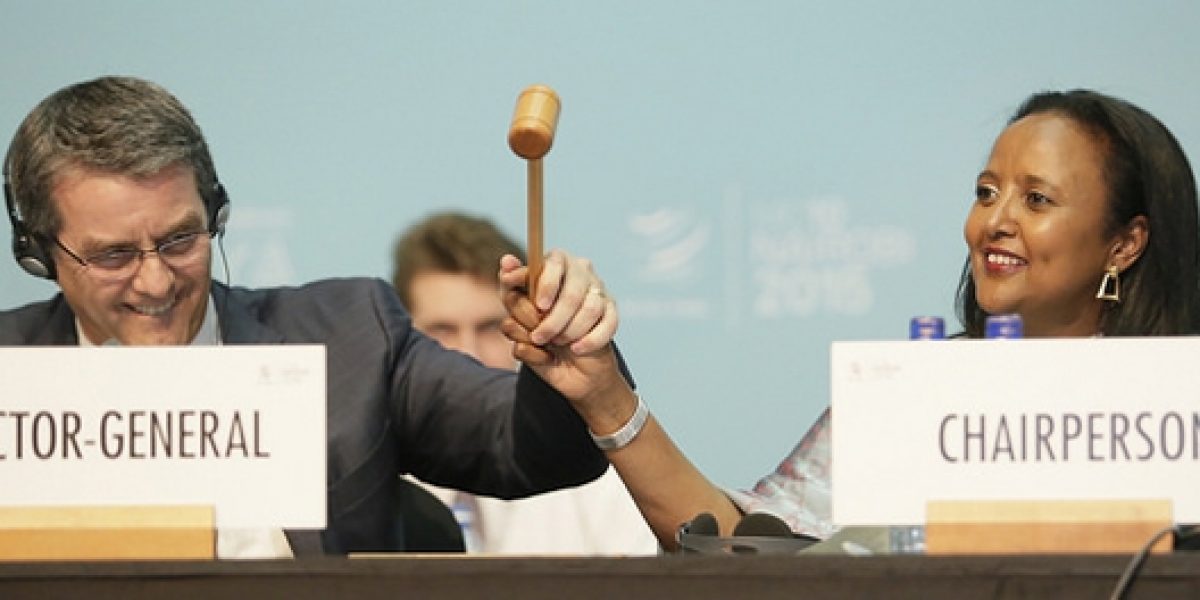Unfortunately the media’s attention on domestic matters shifted focus away from one rather important event in not only South Africa’s biennial calendar but also that of the world. The World Trade Organization’s Ministerial Conference in Nairobi, Kenya was being held for the first time on African soil.
It was understandable why the local media found Minister Nene’s dismissal fascinating; the incident came close to the recall of President Thabo Mbeki in 2008 by the ANC and Minister Nene’s sudden expulsion led to a shock in the markets which worsened the rand’s already externally-induced market volatility. Due to a market outcry, President Zuma had to reverse his decision and he appointed the seasoned Finance Minister Pravin Gordhan. South African media was therefore awash with discusion of President Zuma’s decisions vis-à-vis his Cabinet during the second week of December.
Despite the World Trade Organization (WTO) conference being overshadowed by events at home, South Africa sent a strong delegation led by Minister Davies. After all, the WTO Ministerial, a biennial event that brings together Ministers of Trade from more than a hundred and sixty countries, is the highest decision-making body within the organisation. And the 2015 WTO Ministerial had the unenviable task of concluding the Doha Development Round of trade negotiations, or pulling the plug on it.
When the WTO Ministerial finally ended, the Ministers had not overtly pulled the plug on the Doha Round, which has been underway for nearly fifteen years. However, a conclusion can be made that the conference pulled the plug by omission. The Doha Round can be presumed dead judging from the resolutions taken at the Nairobi Ministerial. With Doha ‘dead’, international trade negotiators now have to pave a way for a post-Doha WTO.
The death of the Doha Round has nothing to do with any particular country. To the contrary, its stillbirth, which would have benefited mostly developing countries, is reflective of the changed global geopolitical architecture in which there is no pure hegemony. The Doha Round was conceived at a time when the US was the undisputed global super-power, totally and willingly in charge of global economic affairs.
However, since then, the world has entered into a vortex with geopolitical and economic power shifting from the US towards China and India. The ambivalence resulting from being in transition has led to the delay and consequent death of the Doha Development Agenda.
Different potential scenarios remain for the future if the multilateral trading system is to remain viable. One possible scenario for such a future is a ‘business as usual’ approach in which traditionally key WTO members such as Canada, the European Union, Japan and the United States further pursue the alternative path of entering into megaregional trade agreements that they are already undertaking. Another possibility is for the United States and possibly China to take a leadership role and exercise that leadership within the WTO.
The third and maybe more legitimate approach would be for emerging powers such as South Africa, Brazil, Mexico, Indonesia among others to assume a leadership role that reflects these countries’ embodiment of the general convergence of interests affecting the multilateral trading system.
This could be done in two ways. Firstly, they could do so by rallying their respective constituencies to reassert the primacy of the WTO on multilateral trade issues. Secondly, considering that most of the key players in the multilateral trading system had already started negotiating megaregionals due to frustration with the lack of progress in the Doha Round, another way of keeping the multilateral trading system relevant could be by ensuring that those mega agreements are brought back to the WTO so that they can become a package of future trade rules.
The catch with this approach is that key developing countries, including South Africa, may not be comfortable with signing up to deals forged predominantly by developed countries outside of the WTO. Fourth, and perhaps more importantly, is to develop and implement a strategy that is informed by the lessons drawn from the failure of the Doha Development Agenda.
One of the main lessons from the Doha Round is the unviability of the single undertaking rule, which dictates that nothing is agreed until everything is agreed, in a world which is in a geopolitical vortex, moving from one hegemon to a bi- or multi-polar context. Intertwined with the single undertaking rule is the consensus principle.
The Doha Round has exposed serious structural flaws in the consensus rule. However, the failure of these conventions should offer new opportunities for strengthening the multilateral trading system. While the consensus principle was effective when the WTO membership was composed of fewer member states that had generally similar economic value systems, inefficiencies became evident when more competing interests were involved.
The way forward would be for the WTO membership, probably led by the US, China, and the EU, to make the WTO regain its position as the epicentre for multilateral trade. This could be done by bringing all the megaregional agreements to the WTO as plurilaterals (voluntary agreements negotiated within the WTO between smaller interest groups). As this approach might face resistance, member states could find a way of involving the WTO dispute settlement mechanism.
The dispute settlement mechanism has proven to be one of the enduring pockets of excellence in the multilateral trading system. Member states can therefore link their megaregionals such as the Trans-Atlantic Trade and Investment Partnership and the Trans-Pacific Partnership to the dispute settlement mechanism. Such a linkage would therefore assist in regulatory harmonisation. It would avoid or remedy the fragmentary effect that megaregionals have had on the multilateral trading system.
Furthermore, WTO member states should consider unpacking the Doha Development Round issues and negotiate them as plurilaterals. Such a sectoral approach would enable members to focus on issues which are most relevant to them. Already there are some success stories in this regard such as the International Technology Agreement.
Member states will therefore negotiate a plurilateral with a view that those that want to join can do so at a later stage. The plurilateral approach could go a long way in moving forward discussions on new issues that the Doha Round did not consider, such as investment, competition and intellectual property rights, among others, within the WTO.
African countries had generally hoped that they would benefit more from the conclusion of this particular trade round. They had hoped this would happen through, for example, getting greater market access concessions especially for agricultural products, save for countries like India and the G33 coalition that sought to prevent the liberalisation of agriculture.
However, due to developing countries having been emboldened by changing geopolitical shifts and being more familiar with the WTO, the round took too long. What also emerged from the Nairobi Ministerial was that the division among member states is no longer based on the traditional North-South divide. Instead, countries’ interests have become complex also owing to the global power and economic dynamics.
For instance, the perennially thorny issues of agricultural subsidies and domestic support are no longer confined to the US and the EU; instead China, Brazil and India have become some of the biggest culprits. This means that there is a need for reconfiguration within developing countries to reflect and deal with the new reality. Countries such as South Africa need to change their approach to the WTO by beginning to embrace and pushing for plurilaterals that have a bearing on developing countries, and through which our trade interests have a realistic chance of being advanced.
The overall picture is that the multilateral trading system will survive post-Nairobi with the Doha Round having been presumed dead. It is up to the US, China, and the EU together with major emerging economies such as South Africa, Russia, Brazil to exercise leadership by rejuvenating one of the most important institutions of the 20th century.
Maybe it is time to reflect on the connection between trade and global security. The current flux in the multilateral trading system should offer member states an opportunity to reflect on how institutions such as the WTO are in existence. The rationale for their existence being that the WTO in many ways helps to promote and maintain global peace and security as trade issues are dealt with in a less politicised setting through the dispute settlement understanding.






